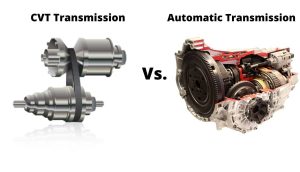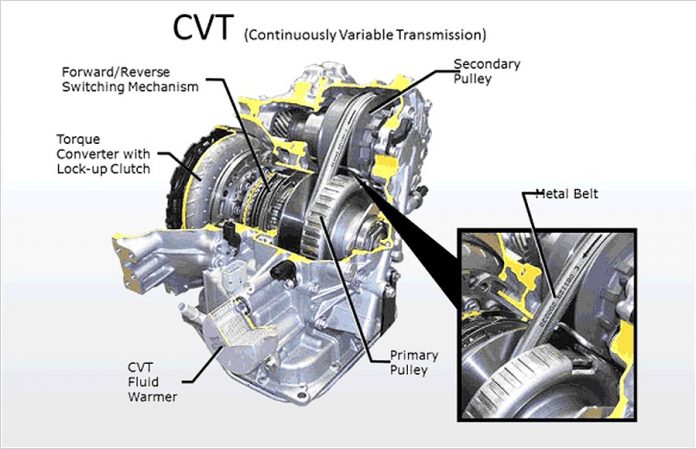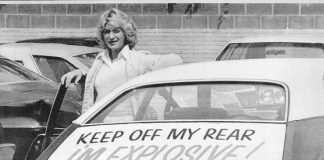In the FX series, The Strain, there is a character who is not quite human and not quite vampire. He battles the vampires on behalf of the humans. He is Mr. Quinlan – aka The Born.
The Continuously Variable (CVT) transmission is like him, in that it was unnaturally conceived – as a way to keep the government at bay.
CVTs do that by slightly increasing gas mileage vs. conventional automatic transmission. Which they do by maintaining optimum leverage for any given road speed or load on the engine. Which they do by continuously varying the relationship between how fast the engine spins and the wheels turn.
Conventional automatics have to continuously shift – up and down – to alter the mechanical driveline ratio for road speed/load. Each gear is a compromise and “just right” for only a given road speed/load. As the speed/load changes, the transmission must shift up – or down – and it’s the in-between these shifts that isn’t as efficient.
The difference in mileage vs. a CVT is about 3 MPG on average. It’s not a big difference but it is a necessary difference – for the sake of not incurring the fines for failing to reach the government’s mandated MPG average, currently set at about 35 MPG.
All new cars must achieve this unnaturally decreed average – their combined city/highway mileage – else the car company that makes them gets fined and passes the cost of the fines on to its customers in the form of a higher sticker price.
The CVT’s job is to prevent that.
It’s an unnatural bargain because it’s one made not between the car company and the car buyer – as would be natural in a free market – but instead it is made between the car company and the government. In balder words: The car buyer didn’t demand the CVT but he gets it anyhow.
He’ll be getting more of them, too – if the Ecuarico-style “election” stands.
The next government has given fair warning that it plans – in the words of the media-anointed El Presidente – “robust” increases in the mandatory minimum MPG regs. (Which raises another interesting point worth discussion some other time about how it came to be that it no longer requires a law being passed by the representatives of the people for government bureaucrats to “mandate” mandatory MPG minimums.)
Well, what’s so bad – and is there anything good – about the CVT?
The main good, of course, is that there is a gas mileage benefit. Which may become more of a benefit once El Presidente-select adds two or three dollars to the cost of a gallon of gas, as he has implied he will do and as he must do if he intends to “end” fossil fuel use in this country, as his crew is champing at the bit to do.
There is also smoothness, arguably the CVT’s most appealing attribute and the one which might have resulted in its success on the market in certain types of cars (ironically, luxury rather than economy cars) absent any government pressure to build them into cars.
CVTs are smooth – a desirable attribute in luxury cars especially – because they don’t shift. They transition from range to range. You depress the accelerator and the car accelerates in a linear progression for as long as you press on the accelerator. Even if you press the accelerator all the way to the floor and hold it there, there’s just the forward thrust without any interruption.
In the same car with a conventional automatic, there is a noticeable transition at each shift from gear to gear; engine speed goes up, then down, then up again. In between a slight pause as the transition occurs and a little snap – forward and then back. This is the “coffee spilling shift shock” which CVTs eliminate – and tout.
These are the good things about the CVT – assuming you don’t think it’s a bad thing to eliminate the feel of up-and-down shifts.
Which brings up some of the bad things about CVTs, the first of which is their mushy characteristic precisely because they do not shift.
The firm feel of gear-to-gear is replaced by a forward surge that can feel like a conventional automatic that’s broken and slipping because it isn’t shifting. In cars with not-very-powerful engines, the surge may not subside until you back off the accelerator, because the engine has to be kept at a fairly high RPM to maintain the wanted acceleration. This is often accompanied by additional noise – of the engine, revving and holding revs – along with the CVT’s own sounds.
In the same car with a conventional automatic, there is less drama – and less noise – because engine speed decreases with each upshift into the next-highest gear.
So there is CVT sturm und drang – as the German saying goes.
Interestingly, it is much-ameliorated if the engine bolted to the CVT is powerful, especially one with lots of low end torque like a big V8. because then there is no necessity to make the engine rev as high – or hold revs as long – to get (and keep) the car going. Ironically, though, CVTs are most prevalently used in cars without powerful engines as a way to improve their efficiency – at the cost of sturm und drang.
But there is another reason why CVTs are mostly used in cars with not-very-powerful engines. It is that CVTs are not as sturdy as conventional automatics. They cannot take heavy loads as reliably and tend to break sooner when used hard.
Ironically – again – they tend to get used harder precisely because they are most often paired with marginally powerful engines. The little four cylinder engine is revved and worked – and so is the transmission. A conventional automatic bolted to a big V8 that easily moves the car without having to dig deep and spin like an Indy car engine just to get the car up to merging speed doesn’t load the transmission as much, which tends to increase the life of the tranny.
CVT reliability has improved but the nature of their design is such that they are more vulnerable to failure if worked hard and when the fail, it is usually permanent. The band in between the adjustable pulleys breaks and sends shards of metal throughout the unit.
Most CVTs are not designed to be repaired but replaced and the replacement cost is often the value of the car itself, since a post-warranty failure at ten years out and with 120,000 miles on the clock isn’t worth paying for – because the car isn’t worth much more than the cost of the replacement transmission.
Such are the pros – and the cons – of the unnatural transmission.
. . .
Got a question about cars, Libertarian politics – or anything else? Click on the “ask Eric” link and send ’em in!
If you like what you’ve found here please consider supporting EPautos.
We depend on you to keep the wheels turning!
Our donate button is here.
If you prefer not to use PayPal, our mailing address is:
EPautos
721 Hummingbird Lane SE
Copper Hill, VA 24079
PS: Get an EPautos magnet or sticker or coaster in return for a $20 or more one-time donation or a $10 or more monthly recurring donation. (Please be sure to tell us you want a magnet or sticker or coaster – and also, provide an address, so we know where to mail the thing!)
If you’d like an ear tag – custom made! – just ask and it will be delivered.
My latest eBook is also available for your favorite price – free! Click here. If that fails, email me at EPeters952@yahoo.com and I will send you a copy directly!












When I was young, I thought I had invented the continuously variable transmission, down to the name. Of course, I hadn’t, but they weren’t yet used in any production vehicle I had heard of. I could see where the action would be psychologically or corporeally unsatisfying, though, I had thought the rocket-like acceleration might be exciting. I’ve still never ridden in one, though.
My Forester XT with a CVT is faster going up my favorite stretch of curvy mountain road than my WRX with a 6-speed manual. Always in the right gear, I guess.
The worst part of a CVT is the incessant DRONE, as the transmission works to constantly keep your engine at the same RPM. Used to be invasively loud in earlier CVTs That sound has been subdued in current models. But if you listen carefully, you’ll hear it’s still there.
Even if the drone is barely audible, it has a subliminally adverse effect upon a driver’s consciousness…….unless of course, the he aspires to become a drone, himself. 😉
Agreed, Mike!
CVTs are the vehicular equivalent of the Face Diaper. Something being foisted on us by the cretins who are “the government.”
I’ve driven a few, and can’t escape the impression they give me of an automatic transmission that’s about to fail. Throttle up, and the RPM increases with no apparent connection to the speed of the car. The lack of a direct connection between my right foot and the engine RPM and the speed of the car is intolerable to me. My ex-wife had one in an Outback. Fortunately, it also had a manual shift feature that acted like an ordinary automatic. That was near ten years ago, so I have no idea if such feature is still available on any CVTs.
Hey Eric, Did you see this? Mazda is trying to bring a straight six engine back. Maybe in a rear drive Mazda 6!!
https://www.autoblog.com/2020/11/12/mazda-straight-six-engine-toyota-partnership-hybrid/
Hi Rich,
Yep; I’ve heard the rumors and hope it happens! It’s an antidote to the bleak news this morning that VA is going to Diaper Lockdown again.
CVTs were originally designed for small 4wheelers and side by side UTVs like John Deere gators or Kawasaki mules. They use a belt that will never be able to handle actual driving like a real automatic or manual can. It might be possible to engineer a CVT to be more durable but would be vost prohibitive.
Hi Anon,
Yup. They use a steel belt in automotive applications but even so – as you say – it’s the weak link in the system. CVTs have their merits, absolutely. But the only reason they’re being used in automotive applications is because of compliance pressure.
The jug of Lucasoil anti-slip stopleak I poured into my slightly leaky 03 automatic today says on it “don’t use in CVT’s.“ I didn’t even know what the heck that was until reading this. Thanks for the timely info!
Engine braking is too important in the way I drive to ever own a CVT powertrain in a car. My 2014 Scion XB has a 4-speed autostick that keeps me close to that aggressive manual transmission feel and power curve…
I always found CVT cars very interesting. Drove a Honda one for a couple months like 15 years ago. Like so many of these fuel economy fudges – when driven in a humane way they can give amazingly good fuel economy. But if you’re ever in a hurry – well would probably make a muscle car of today look fuel efficient, the speed with which it would empty a tank. Suspect its because it just takes the RPM to the peak power range and keeps it there for the whole time… Which is probably not doing any favours for the engine either.
‘assuming you don’t think it’s a bad thing to eliminate the feel of up-and-down shifts’ — EP
In the early days of human heart transplants, some patients were fitted with a mechanical centrifugal pump. Unlike the human heart — effectively a reciprocating pump that produces systolic pulses — a centrifugal pump produces a smooth, steady pressure … like a CVT.
But most of those centrifugal pump recipients died within weeks or months, despite their incomparably smooth, stable blood flow.
Turns out that pulsation between systole and diastole in a natural heart is important. Besides maintaining the tonus of the circulatory system, it conveys vital information to other bodily processes. Take away that essential head-to-toe signal, and the body slowly drifts out of sync and dies.
Transmissions with discrete gears are an example of biophilic design. Like the human pulse, the slight lurch of a shift conveys vital information to an attentive driver — what gear is engaged; whether another up or down shift might be needed, depending on what’s ahead.
One human sense — the tactile sense — is partially nullified with a CVT. Eric describes the disorientation and anxiety induced by a small engine audibly straining at constant speed, while the speed of the vehicle is changing.
It’s as counterintuitive as riding a robotic horse whose footfall shocks are suppressed to provide a ‘running on wheels’ trajectory. Would anyone want to ride such a horse, stripped of its rough, bouncing, horse-like essence? Likewise, would anyone want to own its denatured, benumbed automotive equivalent?
Hi Jim,
Exactly!
I like a positive shift. Just as you say, it conveys necessary information and perhaps more important, it feels right. The changing cadences, syncopating with the road and your speed and how you are driving. It is almost as fun to drive a car with a properly set-up automatic as it is to run through the gears yourself!
My dad, (93 years old, still driving, god bless him), has an 05 Nissan Murano, V6, I think 4.0, with a CVT. You’d never know it’s a CVT, cuz it seems to have “shift points”, and it feels like a regular automatic. As far as durability, hard to say. I hear a lot of bad news about these tranny’s, but dads is fine after all these years. However, his car only has about 45 thousand miles on it, so not really a good indicator.
Hi Florida,
Yes – many CVTs are programmed to simulate shifts but it’s feel-less. No snap. Just an RPM rise/drop/rise. Your dad probably drives his Murano not-too-hard and – as you note – with only 45k on it – I’d expect it to be ok! Problems tend to crop up more-than-average when a CVT-equipped car is run hard and the miles accrue. I’d be okay with a CVT for new (and warranted) small car I intended to use as a commuter and keep for nor more than six years. But if I were to buy the car and meant to keep it for 15-20 (as is my practice) I would want either a manual or a conventional automatic as these just tend to give less trouble over the long haul.
Holy excellent post. I had no idea about any of this. Very interesting, prompts further reading. Thank you!
I wonder how much of the CVT issues are related to trying to marry them to an engine designed with a wide power band? You have the engine and CVT in a tug of war over what the correct ratio should be. Something like a turbine, which has almost no power band but is extremely efficient at a designed RPM seems like an ideal choice for a CVT. But that get really complicated. And it would require a new way to drive that might not be an easy sell.
That could be interesting. Imagine the turbine engine always at a constant, and the throttle controls the workings of the CVT to accelerate/decelerate.
Having an engine run at a constant peak efficiency RPM into a variable drivetrain is the basics of a diesel-electric locomotive. I will never understand why a diesel-hybrid never existed even in countries where diesel in small displacements isn’t so actively discouraged. A 1L diesel in a Prius or Volt would take them to another level in economy and electric assist would overcome the sluggish nature of small diesels.